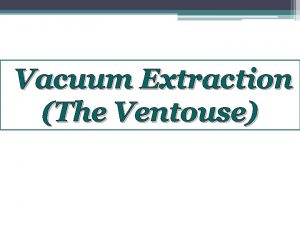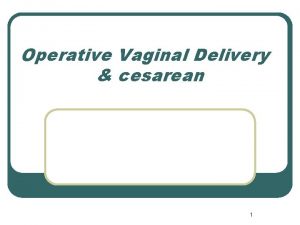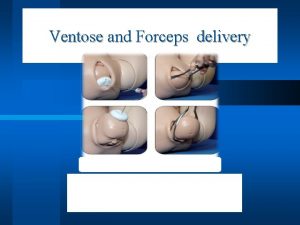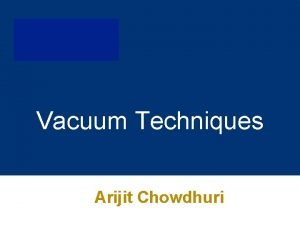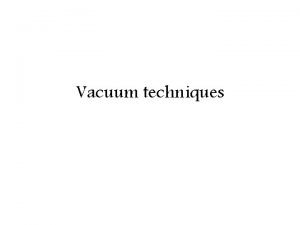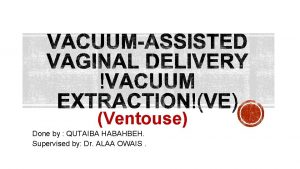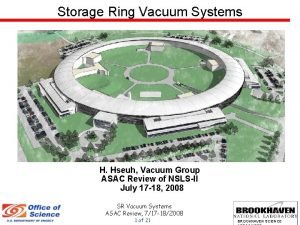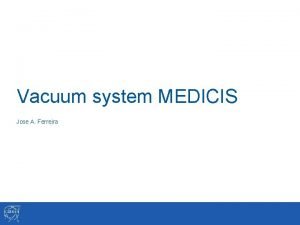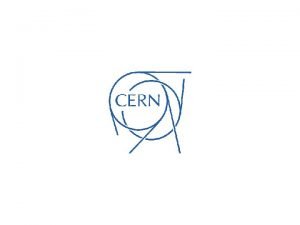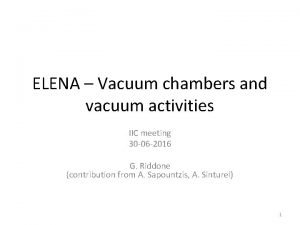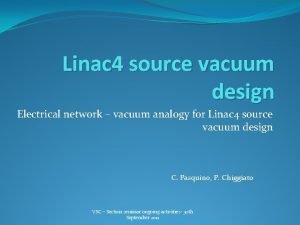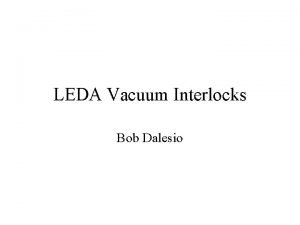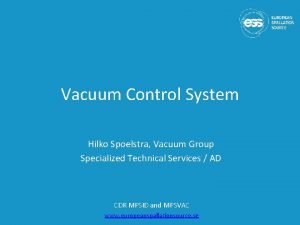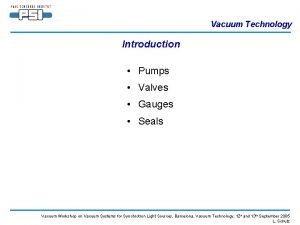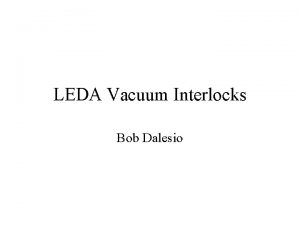Vacuum Extraction The Ventouse Definition It is an












































- Slides: 44

Vacuum Extraction (The Ventouse)


Definition It is an instrumental device designed to assist delivery by creating a vacuum between it and the fetal scalp

INDICATIONS q CONVENTIONAL q NON OBSTETRICS

Conventional uses Ø Shortening second stage (Conditions in which voluntary expulsive efforts are contra indicated) Ø Prolonged second stage Ø Maternal exhaustion ØPresumed fetal jeopardy / fetal distress in late labour Ø Occipito posterior position (persistent occipito posterior or deep transverse arrest) Ø To end trial of labor successfully in borderline CPD Ø To deliver second twin if head is presenting

Non - conventional üTo deliver fetal head at CS üTo deliver frank breech üCompound presentation üTo arrest brisk hemorrhage in minor degree placenta previa with vertex presentation ü To manipulate and deliver large ovarian cysts without enlarging abdominal incision.

Contra indications Ø Inexperience Ø Inability to achieve a proper application ØUncertainty concerning fetal position / station ØSuspicion of moderate to severe feto - pelvic disproportion ØHigh fetal head ( station above 0)

Contd…. ØMalposition ( breech, face, brow) ØAfter coming head of breech ØKnown or suspected fetal coagulation defect ØPrematurity ØIntra uterine fetal death : chignon cannot form Ø Congenital anomalies of fetus: macrosomia Ø Prior scalp sampling

Pre requisites ü When pelvic adequacy is good ü Parturient is willing and able to assist ü An experienced surgeon is present ü Essential pre requisites are: ü Informed consent ü An engaged fetal head ü Legitimate indication ü No suspicion of feto- pelvic disproportion ü Cervical dilatation of at least 7 cm

Either a rigid(metal) Or a flexible ( soft)

Design of vacuum extractor q METAL CUPS q. SILICONE RUBBER CUPS

Parts of Ventouse ü Stainless steel cups in 4 sizes, 30, 40, 50, 60 mm in diameter, Silastic cups are lighter. ü The depth of cup is 20 mm. ü The greatest diameter of cup is 8 mm below the point of application ü The metal plate ü The traction chain attached to the plate ü Traction handle with metal pin ü Pressure rubber tube which encloses the traction chains ü Vacuum bottle with pressure gauge ü Vacuum pump ( manual or electric)


Bird’s modification of Ventouse v. In this modification vacuum tube is attached to the opening near to the periphery of the cup and the traction chain to the hook in the centre of the cup.

Cont… q. There are two types of cups üAnterior cup: used for occipito anterior position üPosterior cup: used for persistent occipito posterior and occipito transverse positions q. Advantages üEasy assembly and easy application üFewer tendencies to slip with oblique traction

Silastic cups Cups made of silastic instead of metal are pliable, softer, less traumatic and safer. They are used more commonly in obstetrics

Plastic cup (mity vac) It consists of a disposable plastic cup and handle, suction tube and a hand pump

Cont… Ø The mity vac hand pump set consists of a tube attached to the cup, a handle that can be pressed to be the vacuum, a pressure release valve, and a pressure gauge. Ø It builds pressure quickly ( within 1 - 2 minutes) and is very handy and transportable and can be used even in the absence of electricity.

Manipulator cup It is a reusable Plastic vacuum Extraction set


Types of cup applications There are four types a. Flexing median: ( correct or ideal application was first defined by Bird in 1976 ) Ø The centre of the cup should be over the vertical point i. e. 3 cm anterior to the posterior fontanel called the “flexion or pivot point” Ø The distance between leading anterior edge of the cup and the anterior fontanel should be 3 cm( 2 finger breadths); this is called the application distance

Ø b. Flexing Para median Ø When the centre of the Cup is situated more than 1 cm to either side of the Saggital suture, but application Distance is 3 cm

c. Deflexing median: when the centre of the cup is situated over the saggital suture, but application distance is less than 3 cm d. Deflexing paramedian : When the centre of the is situated more than 1 cm to either side of the saggital suture , but application distance is less than 3 cm

PROCEDURE q PRELIMINARIES ü Pudendal block or perineal infiltration ü Assemble the equipment ü Test the vaccum q APPLICATION OF THE CUP ü Retract the perineum with two fingers of other hand ü Cup placed against fetal head near occiput ü Knob of the cup should be pointing towards occiput q TRACTION ü Traction must be at right angle to the cup ü Traction synchronus with uterine contraction ü Traction along the axis of birth canal ü Traction should not exceed 30 mins ü No more than 4 successive contraction

Technique of vacuum extraction A proper vacuum extraction depends on: The accuracy of cup application The traction technique The fetal cranial position and station at the time of application The cup design The feto - pelvic relationship

Cont… Positioning : lithotomy position, bladder is emptied, parts painted and draped. Assess : the pre requisites for vacuum extraction by per vaginal examination. (position, station, and attitude of head)

Cont… Anesthesia : perineal infiltration üIn multiparas and low stations no anesthesia üFor high station of head bilateral pudendal block is necessary üGeneral anesthesia is contraindicated (mothers active participation is required)

Cont… Ghosting : A ghost or phantom application is performed prior to the attempt at cup insertion. Assemble the article and check for possible leak

INSERTION OF CUP Aplication of the cup: üThe largest possible cup according to the dilatation of the cervix is to be selected. üThe cup is introduced after retraction of the perineum with two fingers of the other hand. If soft cup is employed, it is partially collapsed by the hand of the operator and then introduced through labia. üRigid cups are turned side ways, the labia are gently spread, and the device is slipped into the vagina.

Cont. . üThe cup is applied directly to fetal scalp as near the posterior fontanel as possible and over the saggital suture üThe knob on the cup should be in the direction of the occiput. üA careful check of cup placement follows (mid saggittal, over pivot point). A finger is swept around the cup to ensure that no maternal tissue is interposed between cup and head

Cont… üA vacuum of 0. 2 kg/cm 2 ( 100 mm. Hg ) is introduced by the pump slowly taking at least 2 minutes sufficient to fix the cup to the fetal head. üWith the onset of contraction, suction pressure is raised to a range of 380 to 580 mm. Hg. (negative pressure should not exceed 600 mm. Hg or 8 kg/cm 2 üBird advised highest possible vacuum level; an electrical pump or vacuum hand pump can be used for this purpose

Cont. . ü During traction and in between contractions, the pressure is applied with two fingers. (thumb against the dome of the cup and index finger on the scalp in front of the cup) of the non-dominant hand over the cup so as to maintain it in firm contact with the head and prevent cup detachment

Cont. . üTraction is applied with the uterine contraction( the mother bearing down) in a direction always perpendicular to the plane of the cup. üOblique traction ( angle of 10 -30 degrees) reduces effective traction force by 25 to 50% üTraction is discontinued between contractions ( intermittent vacuum technique) or if an audible hiss is heard signaling loss of vacuum.

Cont. . ü Chignon is a edematous artificial caput, formed beneath the vacuum cup. ( artificial caput succedaneum)

Traction principles: ü Traction must be at right angle to the cup. ü Traction should be synchronous with the uterine contractions. ü Traction should be made using one hand along the axis of the birth canal. The fingers of the other hand are to be placed against the cup to note the correct angle of traction, rotation and advancement of head. ü The vacuum pump is actuated until the appropriate degree of vacuum is present

Cont… üTension on the extractor handle is allowed to build gradually, paralleling the uterine contractions. üAs the contraction wanes, the tension on the extractor progressively is relaxed. üAt the discretion of surgeon, the vacuum can either be maintained or reduced to less than 200 mm. Hg between contractions. üShould the cup be dislodged, the fetal scalp is to be checked before the cup is reapplied üWhen the contraction subsides, the suction pressure is reduced to 100 mm. Hg üThe sequence is repeated with each contraction üMore than three good attempts are not recommended unless progress is being made.

Cont… üIf there is no advancement during four successive tractions, it is to be abandoned. On no account, traction should exceed 30 minutes. üAs soon as the head is delivered, the vacuum is reduced by opening the screw-release valve and the cup is then detached. The delivery is completed in the normal way.

Ventouse exert 4 types of forces on the fetal scalp: Ø Negative suction from the vacuum it self. Ø Downward traction from pulling. Ø Circular force, if rotation occurs. Ø Shearing force if the direction § of traction is not perpendicular to the scalp surface.

Cont. . Failure rate: üThe mean failure rate for metal vacuum cup is 4. 5% and for the soft cups is 14% üDetachment of the cup( pop – offs) could be because of leak of the vacuum apparatus(mechanical failure) or because of paramedian application combined with oblique traction.

Complications of Vacuum delivery Maternal complications Ø Vaginal lacerations & hemorrhage. Ø Cervical lacerations( if cervix is not fully dilated) Ø Annular detachment of cervix, cervical incompetence. Ø V. V. F. is also reported Ø rupture of pubic symphysis

Fetal complications Ø Mechanical trauma Ø Jaundice Ø Intracranial damage (<0. 5%) Ø Scalp abrasions and lacerations Ø Scalp ecchymosis Ø Cephalic hematoma(accumulation of blood under the periosteum) Ø Skull fracture

Advantages of ventouse over forceps Ø It can be used in un rotated and malrotated occipito - posterior position of the head ØIt can be applied even through incompletely dialated cervix( minimum 7 cm dilatation) ØLesser traction force is needed(10 kg) Ø Safe even when the head is high in second baby of twins ØIt is comfortable and injuries to the mother are less ØFetal complications are less ØRequires less technical skill(suitable for trained midwives

Cont… ØCompression force is less ( 1/20 th of forceps) ØDoes not require additional space between tight fitting head and pelvis ØMaternal morbidity is less than that with forceps deliveries

Advantages of forceps over vacuum ØCan be applied to after coming head of breech or anterior face ØCan be applied to face presentation ØCan be applied to dead fetus ØA vacuum extraction operation has a higher failure rate than a forceps operation ØFetal soft tissue trauma ( especially cephal hematoma and retinal hemorrhages) is less
 Advantages of ventouse over forceps
Advantages of ventouse over forceps Define simple distillation
Define simple distillation Vacuum tube computer definition
Vacuum tube computer definition Maceration meaning
Maceration meaning What is analytical chemistry definition
What is analytical chemistry definition Hát kết hợp bộ gõ cơ thể
Hát kết hợp bộ gõ cơ thể Frameset trong html5
Frameset trong html5 Bổ thể
Bổ thể Tỉ lệ cơ thể trẻ em
Tỉ lệ cơ thể trẻ em Voi kéo gỗ như thế nào
Voi kéo gỗ như thế nào Tư thế worms-breton
Tư thế worms-breton Bài hát chúa yêu trần thế alleluia
Bài hát chúa yêu trần thế alleluia Kể tên các môn thể thao
Kể tên các môn thể thao Thế nào là hệ số cao nhất
Thế nào là hệ số cao nhất Các châu lục và đại dương trên thế giới
Các châu lục và đại dương trên thế giới Công thức tiính động năng
Công thức tiính động năng Trời xanh đây là của chúng ta thể thơ
Trời xanh đây là của chúng ta thể thơ Cách giải mật thư tọa độ
Cách giải mật thư tọa độ Làm thế nào để 102-1=99
Làm thế nào để 102-1=99 độ dài liên kết
độ dài liên kết Các châu lục và đại dương trên thế giới
Các châu lục và đại dương trên thế giới Thơ thất ngôn tứ tuyệt đường luật
Thơ thất ngôn tứ tuyệt đường luật Quá trình desamine hóa có thể tạo ra
Quá trình desamine hóa có thể tạo ra Một số thể thơ truyền thống
Một số thể thơ truyền thống Cái miệng nó xinh thế
Cái miệng nó xinh thế Vẽ hình chiếu vuông góc của vật thể sau
Vẽ hình chiếu vuông góc của vật thể sau Nguyên nhân của sự mỏi cơ sinh 8
Nguyên nhân của sự mỏi cơ sinh 8 đặc điểm cơ thể của người tối cổ
đặc điểm cơ thể của người tối cổ Ví dụ giọng cùng tên
Ví dụ giọng cùng tên Vẽ hình chiếu đứng bằng cạnh của vật thể
Vẽ hình chiếu đứng bằng cạnh của vật thể Fecboak
Fecboak Thẻ vin
Thẻ vin đại từ thay thế
đại từ thay thế điện thế nghỉ
điện thế nghỉ Tư thế ngồi viết
Tư thế ngồi viết Diễn thế sinh thái là
Diễn thế sinh thái là Dot
Dot So nguyen to
So nguyen to Tư thế ngồi viết
Tư thế ngồi viết Lời thề hippocrates
Lời thề hippocrates Thiếu nhi thế giới liên hoan
Thiếu nhi thế giới liên hoan ưu thế lai là gì
ưu thế lai là gì Hổ đẻ mỗi lứa mấy con
Hổ đẻ mỗi lứa mấy con Sự nuôi và dạy con của hươu
Sự nuôi và dạy con của hươu Hệ hô hấp
Hệ hô hấp
